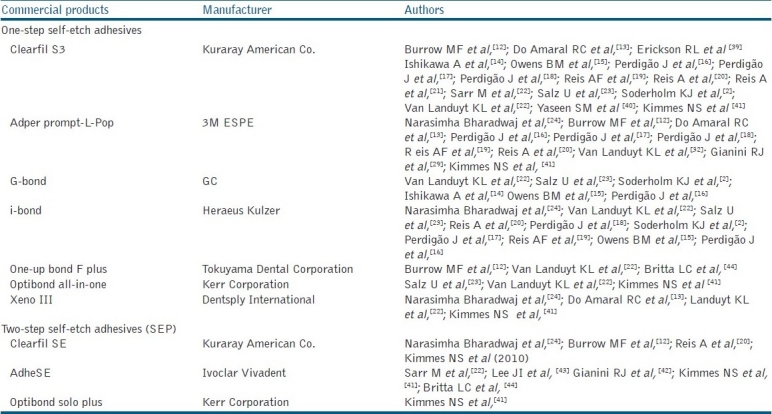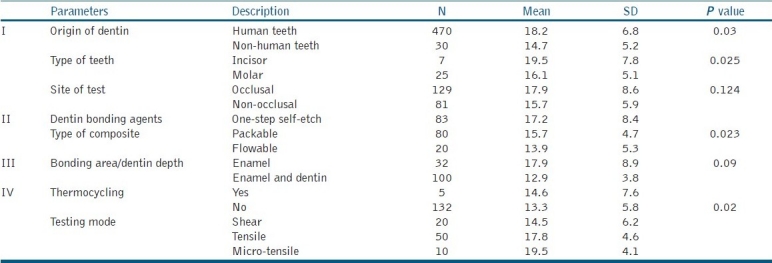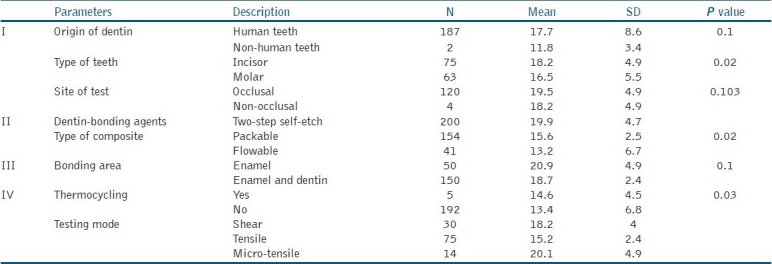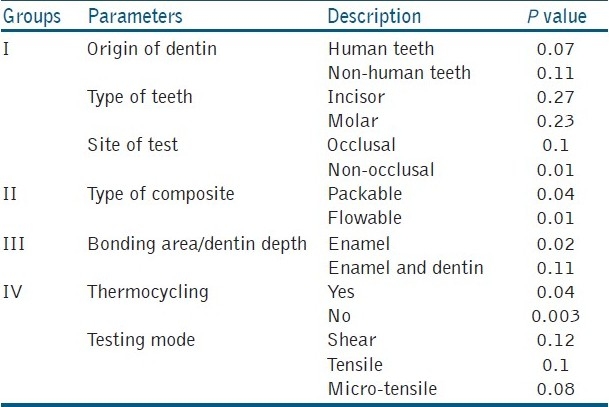Abstract
Aim:
The purpose of this study is to critically evaluate the factors that affect the bond strength of one-step and two-step self-etch adhesives by using meta-analysis.
Materials and Methods:
Potential papers that were selected according to inclusion and exclusion criteria from articles were published in 13 peer-reviewed journals using “PubMed data base”. From each report, means and standard deviations of bond strengths were extracted and tabulated with corresponding experimental conditions.
Results:
All the studied parameters showed no significant difference, except for dentin origin/site and bonding area. In addition, statistical analysis done with ANOVA showed statistical significance between the one-step and two-step self-etch adhesives.
Conclusions:
Our analysis has showed that two-step self-etch adhesive system showed a superior in vitro performance in comparison to one-step self-etch system. Nevertheless, certain factors such as dentin origin, site and area of bonding affect the bond strength of adhesives.
Keywords: Bonding agents, meta-analysis review, self-etch adhesive
INTRODUCTION
Aesthetic restorative materials have gained considerable importance over a period. Bonding to enamel is been considered satisfactory, but adhesion to dentin is much more complex due to the nature of the substrate.
The best way to test the effectiveness of a biomaterial, as well as composite or luting cement or a bonding system, is in vivo experimentation in controlled trials. However, it is quite impossible to distinguish by clinical evaluation and adhesion potential of a dentin-bonding system from many other parameters that influence either the quality or the longevity of a restoration.
Theoretically, in vitro bonding tests would allow for measurement of the true strength of bonding of a given system to a dentinal substrate. Unfortunately, in vitro dentin adhesion testing has not been very successful in predicting in vivo effectiveness, probably because of the number of factors influencing test results and clinical relevance.[1–3]
Several authors have already studied the influence of some of these factors, such as the origin of the substrate,[4] substrate storage,[5] dentin depth,[6] type of composite,[7] testing mode,[8] etc. Some previous reviews have listed most of the variables influencing dentin bond strength,[9] but none has quantified their importance or defined their statistical significance.
The purpose of this study is to evaluate the true factor that affects the bond strength of one-step and two-step self-etch adhesive. This quantitative overview could be considered as a meta-analysis study performed under non-experimental conditions to assess the effects of certain clinical parameters on bond strength of adhesives.
MATERIALS AND METHODS
Data collection
Potential papers were selected from articles published in 13 peer-reviewed journals using “PubMed data base”. American Journal of Dentistry, Journal of Adhesive Dentistry, British Dental Journal, Dental Materials, European Journal of Oral Science, International Dental Journal, Journal of Dentistry, Journal of Dental Research, Journal of Oral Rehabilitation, Journal of Prosthetic Dentistry, Operative Dentistry, Quintessence International and Journal of Conservative Dentistry.
Inclusion criteria
Study with original data.
Paper published in English or translated to English.
Only studies measuring the bond strength of one-step and two-step self-etch dentin-bonding agents to be included.
The bonding agents that are commercially available and tested by shear or tensile mode on sound dentin from permanent teeth.
Dentin-bonding agents involved in the analysis should have been tested in at least five different studies.
The outcome measure had to be the dentin bond strength expressed in MPa/Psi.
Among the selected studies, some exclusion criteria applied.
Paper displaying only graphic data.
Dentin-bonding agents not used according to manufacturer's instructions.[7]
Dentin samples, which were contaminated or not treated under clinical conditions before application of the dentin-bonding agents, were excluded from the analysis
Study without data analysis.
We classified the parameters into four groups: Group A - Factors related to the dentin substrate; Group B - Type of composite and dentin-bonding agents; Group C - Bonding area and; Group D - Thermocycling and testing mode . All the selected article were summarized in Table 1 according to the commercial products.
Table 1.
Selected studies were included in the meta-analysis

Statistical analysis
The problem of bond-strength testing is that the materials were seldom compared with a standard. Rather, different materials were tested under various conditions and bond strengths are reported as point estimates and expressed in MPa. It is difficult to compute a standard effect size for each study, as required in a classic meta-analysis. Thus, we decided to analyze directly the measures of bond strength from reports published in literature. This quantitative overview was performed in non-experimental conditions since materials and conditions are not allocated randomly.
From each report means and standard deviations of bond strengths were extracted and tabulated with corresponding experimental conditions. The Statistical Analysis Software System MIX 2.0 Professional (Biostat, Englewood, NJ) was used to perform the statistical analysis. Differences between means were computed with analysis of variance.
RESULTS
Tables 2 and 3 show descriptive statistics of different parameters tabulated from the selected studies according to the four groups described in materials and methods section. Some parameters, such as tooth storage medium and dentin surface topography, were not included in the statistical analysis, due to their greater variability or lack of information. It was noted that about one-third of the selected articles provided such information and that the distinction between the different failure modes was not always available and clearly identified. For this reason, both composite and dentin cohesive failures were grouped together. One-way ANOVA comparison between one-step and two-step self-etch adhesives is given in Table 4 The P-values indicate the potential relation between each parameter and the bond strength. Their respective influences were given by the P-value at the significance level of 0.05(α). All the studied parameters showed no significant difference, except for dentin origin/site and bonding area. In addition, statistical analysis done with ANOVA showed statistical significance between the one-step and two-step self-etch adhesives.
Table 2.
Descriptive statistics of the different parameters studied using one-step self-etch adhesives

Table 3.
Descriptive statistics of the different parameters studied using two-step self-etch adhesives

Table 4.
Comparison between one-step and two-step self-etch adhesives using ANOVA

DISCUSSION
As quoted by DerSimonian and Laird (1986) “Meta-analysis is the statistical analysis of a collection of analytic results for the purpose of integrating the findings.” The advantage of meta-analysis over the traditional literature review is the possibility of combining results from many studies and analyzing the factors that affect the bond strength of self-etch adhesives.[25]
In the studies selected, the tensile or shear testing was done using a constant crosshead speed and the samples were continuously loaded such that the crack will propagate at increasing speed until separation. In a clinical situation, the propagation kinetics of the crack is completely different. During function, an assembly is submitted to a series of brief loads. If these loads are high enough, small extensions of cracks ensure sub-critical crack growth in bonded area as explained by A. A. Griffith. According to Griffith's theory of brittle solid it is stated that the low fracture strength observed in experiments, as well as the size-dependence of strength, were due to the presence of microscopic flaws in the bulk material.[26] In this practical situation, the crack speed is much lower than during tensile or shear forces, which is used to determine the adhesion potential of a dentin-bonding system. Conventional tests may be simple and fast but they have many drawbacks. The location of the initial flaw is unknown, and the stress concentration at the bonded interface is non-uniform and unpredictable. Moreover, the stress distribution is highly dependent on the test geometry, on the loading mode and on the material properties.[27–29]
Our analysis revealed that the origin of dentin, site of bonding and bonding area had significant influence on bond strength of one-step and two-step self-etch adhesive.
The studies have also showed that there is a difference in bond strength between human teeth and bovine teeth. This difference explains the fact that dentinal tubules are large in the coronal portion of bovine dentin, but one study by Nakamichi et al,[30] showed that there is no difference in bond strength between bovine and human dentin when only the superficial layers was used.
Studies also showed that the bond strength varied between buccal and occlusal surfaces. Oilo and Olsson[31] showed that the tensile strength is higher on the buccal surface compared to the occlusal surface, which could be explained by the fact that the tubules are lower in number with less area percentage on the buccal surface than on the occlusal surface.
The analysis also showed a definite difference between enamel and dentin bonding which might be explained by various reasons. Dentin has a heterogeneous structure and different orientation of tubules with root dentin having smaller and more numerous branching of tubules when compared to crown dentin. Acidity of monomer also caused change in surface chemistry and morphology of dentin, which in turn can influence bonding. A significantly thicker hybrid layer was noted in areas with perpendicular tubule orientation than in areas with parallel tubule orientation[32]
Surface area significantly affects the bond strength in one-step and two-step self-etch adhesives. Bond strength is calculated as the load at failure divided by the cross-sectional area of the bonded surface. An inverse relationship between bond strength and bonded surface area has been recently shown,[33] confirming previous studies.[34] These authors explain the lower strengths of large bonded samples by the greater number of defects within the adhesive joint.
Burrow MF et al, stated that Clearfil SE Bond showed no statistical difference to G-Bond.[12] Do Amaral RC et al, suggested application of bonding agents with agitation on the dentin surface to improving the resin-dentin bond strength of one-step self-etch adhesives.[13] When bonded to dentin, the adhesives with simplified application procedures (in particular, one-step self-etch adhesives) still underperform as compared to conventional three-step adhesives. “Mild” two-step self-etch adhesives that provide additional chemical bonding, appear to most optimally combine bonding effectiveness with a simplified application protocol[22]
Our analysis has showed that two-step self-etch adhesive system showed a superior in vitro performance in comparison to one-step self-etch system. These results are in accordance with those of other studies.[14,24,35,36,38]
The bonding ability of the all-in-one adhesives depends on their specific composition. In light of the low in vitro bond strengths and high rate of spontaneous failures of some all-in-one adhesives compared to those of the two-step adhesives, the newest adhesives should be screened more strictly before they are recommended for clinical use.[14]
One-step self-etch adhesives showed higher bond strengths on ground enamel and no reductions in resin-enamel bonds were observed after 12 months of water storage. Marginal adaptation was significantly better for Clearfil S3 Bond than for Adper Prompt L-Pop.[15]
Serious limitation of all-in-one adhesives are as follows: incomplete polymerization and continued demineralization of the adjacent dentin structure in the tubules. For all-in-one adhesives to be acidic, the formulation have become more hydrophilic, thereby allowing deeper penetration. As these adhesives penetrate the wet dentinal tubules deeply, the water content increases. Studies have shown that this water acts as a major interfering factor in polymerization which leads to unpolymerized acidic and aggressive monomers to continue etching the dentin, thereby leading to a detrimental impact on the bond.[35]
Other factor leading to low bond strength and failure of resin-based adhesives in vivo are harsh conditions of the oral environment, such as intraoral temperature, moisture contact, fatigue of bond due to tooth flexure and bacterial enzymes.[37]
The shelf life of one-component self-etching adhesives is determined by their chemical composition. In conventional methacrylate-based adhesives (AdheSE), the inherently acidic environment of such formulations leads to monomer degradation due to hydrolysis. In contrast, methacrylamide-based adhesives are stable to aqueous acid and exhibit much superior storage stability without monomer degradation-related losses in adhesion performance.[23]
Intermediary strong’ self-etch adhesives (AdheSE and Xeno III) exhibited significantly superior shear bond strength values compared to both ‘strong’ (Prompt-L-Pop) and ‘weak’ (Clearfil SE Bond) self-etch systems, which implies that pH of the adhesive has a significant effect on the bond strength.[24]
Another major variable in bond strength tests is the depth of dentin. Suzuki and Finger[1] found a linear relationship between the remaining dentin thickness to the pulp and the shear bond strengths of three different adhesives, an observation subsequently confirmed by other authors[6,16]
The analysis surprisingly showed that type of composite and thermocycling did not significantly affect bond strength. Nevertheless, three studies reported a decrease in adherence after thermocycling[31,32] whereas other studies reported an increase, depending on the adhesive system tested.[31]
CONCLUSION
From this meta-analysis study, we have analyzed that two-step self-etch adhesive showed better bonding ability than one-step self-etch adhesives. Thereby, several clinical parameters among which dentin origin, site and area of bonding have shown a significant influence on mean bond strength of adhesive system. Thus, our study suggests, that the practitioners can easily control these parameters by using standardized protocol for the clinical success of self-etch adhesive systems.
Footnotes
Source of Support: Nil
Conflict of Interest: None declared
REFERENCES
- 1.Finger WJ. Dentin bonding agents. Relevance of in vitro investigations. Am J Dent. 1988;1:184–8. [PubMed] [Google Scholar]
- 2.Soderholm KJ. Correlation of in vivo and in vitro performance of adhesive restorative materials: A report of the ASC MD156 Task Group on Test Methods for the Adhesion of Restorative Materials. Dent Mater. 1991;7:74–83. doi: 10.1016/0109-5641(91)90049-5. Correlation of in vivo and in vitro performance of adhesive restorative materials: A report of the ASC MD156 Task Group on Test Methods for the Adhesion of Restorative Materials Dent Mater 1991;7:74-83. [DOI] [PubMed] [Google Scholar]
- 3.Van Noort R. Clinical relevance of laboratory studies on dental materials: Strength determination-a personal view. J Dent. 1994;22:S4–8. doi: 10.1016/0300-5712(94)90163-5. [DOI] [PubMed] [Google Scholar]
- 4.Fowler CS, Swartz ML, Moore BK, Rhodes BF. Influence of selected variables on adhesion testing. Dent Mater. 1992;8:265–9. doi: 10.1016/0109-5641(92)90097-v. [DOI] [PubMed] [Google Scholar]
- 5.Goodis HE, Marshall GW, Jr, White JM, Gee L, Hornberger B, Marshall SJ. Storage effects on dentin permeability and shear bond strengths. Dental Materials. 1993;9:79–84. doi: 10.1016/0109-5641(93)90079-6. [DOI] [PubMed] [Google Scholar]
- 6.Prati C, Pashley DH. Dentin wetness, permeability and thickness and bond strength of adhesive systems. Am J Dentistry. 1992;5:33–8. [PubMed] [Google Scholar]
- 7.Perdigao J, Swift EJ, Cloe BC. Effects of etchants, surface moisture, and resin composite on dentin bond strengths. Am J Dent. 1993;6:61–4. [PubMed] [Google Scholar]
- 8.Kitasako Y, Burrow MF, Nikaido T, Harada N, Inokoshi S, Yamada T, et al. Shear and tensile bond testing for resin cement evaluation. Dent Mater. 1995;11:298–304. doi: 10.1016/0109-5641(95)80024-7. [DOI] [PubMed] [Google Scholar]
- 9.Diaz-Arnold AM, Williams VD, Aquilino SA. A review of dentinal bonding in vitro: The substrate. Oper Dent. 1990;15:71–5. [PubMed] [Google Scholar]
- 10.Lee SY, Greener EH. Effect of excitation energy on dentine bond strength and composite properties. J Dent. 1994;22:175–81. doi: 10.1016/0300-5712(94)90202-x. [DOI] [PubMed] [Google Scholar]
- 11.Miyazaki M, Hinoura K, Onose H, Moore BK. Influence of light intensity on shear bond strength to dentin. Am J Dent. 1995;8:245–8. [PubMed] [Google Scholar]
- 12.Burrow MF, Kitasako Y, Thomas CD, Tagami J. Comparison of enamel and dentin microshear bond strengths of a two-step self-etching priming system with five all-in-one systems. Oper Dent. 2008;33:456–60. doi: 10.2341/07-125. [DOI] [PubMed] [Google Scholar]
- 13.Do Amaral RC, Stanislawczuk R, Zander-Grande C, Gagler D, Reis A, Loguercio AD. Bond strength and quality of the hybrid layer of one-step self-etch adhesives applied with agitation on dentin. Oper Dent. 2010;35:211–9. doi: 10.2341/09-198-L. [DOI] [PubMed] [Google Scholar]
- 14.Ishikawa A, Shimada Y, Foxton RM, Tagami J. Micro-tensile and micro-shear bond strengths of current self-etch adhesives to enamel and dentin. Am J Dent. 2007;20:161–6. [PubMed] [Google Scholar]
- 15.Owens BM, Johnson WW. Effect of single step adhesives on the marginal permeability of Class V resin composites. Oper Dent. 2007;32:67–72. doi: 10.2341/06-17. [DOI] [PubMed] [Google Scholar]
- 16.Perdigão J, Gomes G, Gondo R, Fundingsland JW. In vitro bonding performance of all-in-one adhesives. Part I--microtensile bond strengths. J Adhes Dent. 2006;8:367–73. [PubMed] [Google Scholar]
- 17.Perdigão J, Dutra-Corrêa M, Castilhos N, Carmo AR, Anauate-Netto C, Cordeiro HJ, et al. One-year clinical performance of self-etch adhesives in posterior restorations. Am J Dent. 2007;20:125–33. [PubMed] [Google Scholar]
- 18.Perdigão J, Dutra-Corrêa M, Anauate-Netto C, Castilhos N, Carmo AR, Lewgoy HR, et al. Two-year clinical evaluation of self-etching adhesives in posterior restorations. J Adhes Dentistry. 2009;11:149–59. [PubMed] [Google Scholar]
- 19.Reis AF, Bedran-Russo AK, Giannini M, Pereira PN. Interfacial ultramorphology of single-step adhesives: Nanoleakage as a function of time. J Oral Rehabil. 2007;34:213–21. doi: 10.1111/j.1365-2842.2006.01656.x. [DOI] [PubMed] [Google Scholar]
- 20.Reis A, Moura K, Pellizzaro A, Dal-Bianco K, de Andrade AM, Loguercio AD. Durability of enamel bonding using one-step self-etch systems on ground and unground enamel. Oper Dent. 2009;34:181–91. doi: 10.2341/08-58. [DOI] [PubMed] [Google Scholar]
- 21.Reis A, Leite TM, Matte K, Michels R, Amaral RC, Geraldeli S, et al. Improving clinical retention of one-step self-etching adhesive systems with an additional hydrophobic adhesive layer. J Am Dent Assoc. 2009;140:877–85. doi: 10.14219/jada.archive.2009.0281. [DOI] [PubMed] [Google Scholar]
- 22.Sarr M, Kane AW, Vreven J, Mine A, Van Landuyt KL, Peumans M, et al. Microtensile bond strength and interfacial characterization of 11 contemporary adhesives bonded to bur-cut dentin. Oper Dent. 2010;35:94–104. doi: 10.2341/09-076-L. [DOI] [PubMed] [Google Scholar]
- 23.Salz U, Bock T. Adhesion performance of new hydrolytically stable one-component self-etching enamel/dentin adhesives. J Adhes Dent. 2010;12:7–10. doi: 10.3290/j.jad.a18439. [DOI] [PubMed] [Google Scholar]
- 24.Narasimha Bharadwaj, KS Karthikeyhan, VG Sukumaran. Comparative shear bond strength analysis of strong, intermediary strong and mild 'self- etch′ systems, and a hypothesis on their chemical behavior on dentin. J Conservat Dent. 2005;8:24–30. [Google Scholar]
- 25.DerSimonian R, Laird N. Meta-Analysis in Clinical Trials. Control Clin Trials. 1986;7:177–88. doi: 10.1016/0197-2456(86)90046-2. [DOI] [PubMed] [Google Scholar]
- 26.Griffith AA. The phenomena of rupture and flow in solids. Philos Trans Royal Soc Lond. 1921;221:163–98. [Google Scholar]
- 27.van Noort R, Cardew GE, Howard IC, Noroozi S. The effect of local interfacial geometry on the measurements of the tensile bond strength to dentin. J Dent Res. 1991;70:889–93. doi: 10.1177/00220345910700050501. [DOI] [PubMed] [Google Scholar]
- 28.Versluis A, Tantbirojn D, Douglas WH. Why do shear bond tests pull out dentin? J Dent Res. 1997;76:1298–307. doi: 10.1177/00220345970760061001. [DOI] [PubMed] [Google Scholar]
- 29.Tantbirojn D, Cheng YS, Versluis A, Hodges JS, Douglas WH. Nominal shear or fracture mechanics in the assessment of composite-dentin adhesion? J Dent Res. 2000;79:41–8. doi: 10.1177/00220345000790010601. [DOI] [PubMed] [Google Scholar]
- 30.Nakamichi J, Iwaku M, Fusayama T. Bovine teeth as possible substitutes in the adhesion test. J Dent Res. 1983;62:1076–81. doi: 10.1177/00220345830620101501. [DOI] [PubMed] [Google Scholar]
- 31.Oilo G, Olsson S. Tensile bond strength of dentin adhesives: A comparison of materials and methods. Dent Materi. 1990;6:138–44. doi: 10.1016/s0109-5641(05)80045-4. [DOI] [PubMed] [Google Scholar]
- 32.Carvalho RM, Mendonça JS, Santiago SL, Silveira RR, Garcia FC, Tay FR, et al. Effects of HEMA/solvent combinations on bond strength to dentin. J Dent Res. 2003;82:597–601. doi: 10.1177/154405910308200805. [DOI] [PubMed] [Google Scholar]
- 33.Phrukkanon S, Burrow MF, Tyas MJ. The influence of crosssectional shape and surface area on the microtensile bond test. Dent Mater. 1998;14:212–21. doi: 10.1016/s0109-5641(98)00034-7. [DOI] [PubMed] [Google Scholar]
- 34.Sano H, Shono T, Sonoda H, Takatsu T, Ciucchi B, Carvalho R, et al. Relationship between surface area for adhesion and tensile bond strength-evaluation of a micro-tensile bond test. Dent Mater. 1994;10:236–40. doi: 10.1016/0109-5641(94)90067-1. [DOI] [PubMed] [Google Scholar]
- 35.Wang Y, Spencer P. Continuing etching of an all-in-one adhesives in wet dentin. J Dent Res. 2005;84:350–4. doi: 10.1177/154405910508400411. [DOI] [PubMed] [Google Scholar]
- 36.Chopra V, Sharma H, Datta PS. A comparative evaluation of the bonding efficacy of two-step vs all-in-one bonding agents- An, in-vitro study. J Conservat Dent. 2009;12:101–4. doi: 10.4103/0972-0707.57632. [DOI] [PMC free article] [PubMed] [Google Scholar]
- 37.Burrow MF, Harada N, Kitasako Y, Nikaido T, Tagami J. Seven years dentin bond strength of a total and self etch system. Eur J Oral Sci. 2005;113:265–70. doi: 10.1111/j.1600-0722.2005.00213.x. [DOI] [PubMed] [Google Scholar]
- 38.Shekhar D. Comparative evaluation of micro-shear bond strength of adhesive resins to coronal dentin versus dentin at floor of pulp chamber - An Invitro Study. J Conservat Dent. 2006;9:123–30. [Google Scholar]
- 39.Erickson RL, Barkmeier WW, Latta MA. The role of etching in bonding to enamel: A comparison of self-etching and etch-and-rinse adhesive systems. Dent Mater. 2009;25:1459–67. doi: 10.1016/j.dental.2009.07.002. [DOI] [PubMed] [Google Scholar]
- 40.Yaseen SM, Subba Reddy VV. Comparative evaluation of shear bond strength of two self-etching adhesives (sixth and seventh generation) on dentin of primary and permanent teeth: An in vitro study. J Indian Soc Pedod Prev Dent. 2009;27:33–8. doi: 10.4103/0970-4388.50814. [DOI] [PubMed] [Google Scholar]
- 41.Kimmes NS, Barkmeier WW, Erickson RL, Latta MA. Adhesive bond strengths to enamel and dentin using recommended and extended treatment times. Oper Dent. 2010;35:112–9. doi: 10.2341/09-081-L. [DOI] [PubMed] [Google Scholar]
- 42.Gianini RJ, do Amaral FL, Flório FM, Basting RT. Microtensile bond strength of etch-and-rinse and self-etch adhesive systems to demineralized dentin after the use of a papain-based chemomechanical method. Am J Dent. 2010;23:23–8. [PubMed] [Google Scholar]
- 43.Lee JI, Park SH. The effect of three variables on shear bond strength when luting a resin inlay to dentin. Oper Dent. 2009;34:288–92. doi: 10.2341/08-82. [DOI] [PubMed] [Google Scholar]
- 44.Britta LC, Martins M, França FM. Influence of different primer application times on bond strength of self-etching adhesive systems to unground enamel. Oper Dent. 2009;34:43–50. doi: 10.2341/08-35. [DOI] [PubMed] [Google Scholar]


